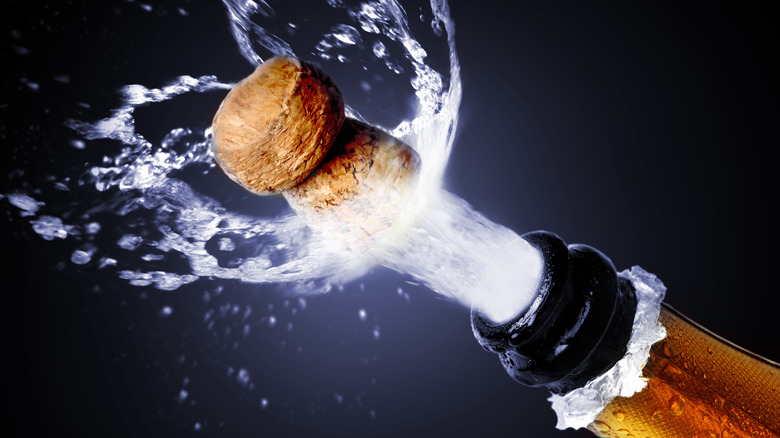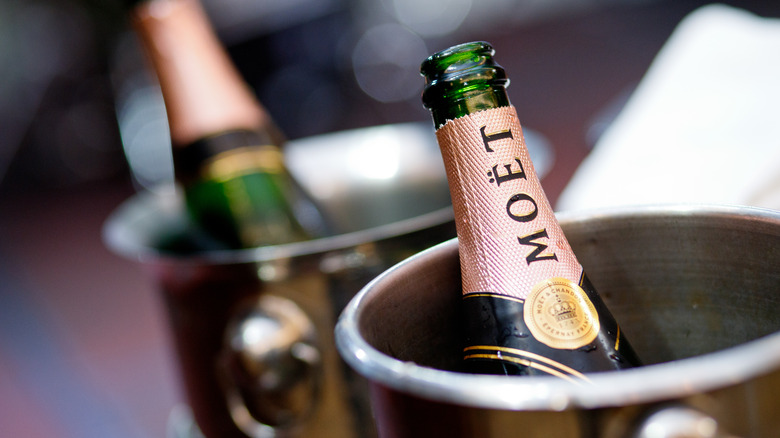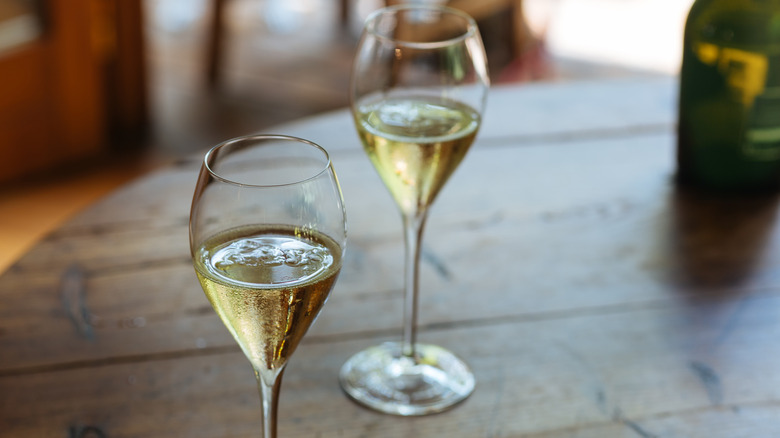The Real Difference Between Bubbly Faves Prosecco And Champagne
There's nothing quite like hearing that quintessential popping sound at a party: the uncorking of a chilled bottle of bubbly. Watching the gold-colored liquid foam over a flute glass is one of the most luxurious sights, whether it's Champagne or Prosecco. But do you know the difference between the two? Because not all sparkling wine is created equal.
If you're stumped looking at a wine list, you're not alone. The range of sparkling wine is notably diverse and most remarkable beyond first impressions. There's Cava, Spain's take on sparkling wine that is made primarily in Catalonia (via Food & Wine). Then there's Espumante, the Portuguese version, which brings in a lighter, more floral aroma (via SommTable). The two dueling glasses we see most often though are Champagne and Prosecco. So what exactly separates the two great pleasures, and which one should you order? It turns out there's more than meets the eye.
Champagne comes from Champagne, France
According to experts at Wine Folly, the main difference is simple: Champagne is made in France, and Prosecco is made in Italy. But more than their regional homelands, there are also differences in production processes and how much you'll end up paying for a glass.
In the 17th century, the French were the first to create a sparkling wine, establishing dominion and proper ownership over the drink (via Champagne411). To this day, a glass of sparkling wine cannot be called champagne unless made in the French region of Champagne, an area about 80 miles north of Paris, France (via Food52). According to Comité Champagne, it is even protected by French AOC or Appellation d'Origine Controllé, meaning its authenticity is linked to its region of origin and protected by law. A bottle of proper Champagne is made with a blend of Chardonnay, Pinot Noir, and Pinot Meunier grapes, and it goes through two fermentation processes that can take up to ten years to complete (via Food & Wine). Per Wine-Searcher, Champagne is not legally ready to be sold until it has aged at least 15 months in a bottle. The process of formulating Champagne takes an incredible amount of craftsmanship and is a long-held French tradition protected and revered by its people. Wine experts say you should expect to pay at least $40 for a respected bottle of French bubbly, and it should have citrus-forward flavors with hints of almond.
Thank the Italians for Prosecco
Like champagne, Prosecco is protected by law as a Denominazione di Origine Controllata or DOC, meaning it can only be called Prosecco if made in the northern region of Italy (via MasterClass). However, unlike Champagne, which goes through an expensive production process, the Italian's "Tank Method," where the fermentation is done in a closed tank before being bottled, is much more cost-efficient. You can expect to pay a reasonable $20 for a bottle of the Italian bubbly (via Wine Folly).
Prosecco is also made mainly from a white grape called glera, giving it a fruitier melon-like flavor profile. Due to its one-time tank fermentation process, Prosecco also has a lighter, foamier crisp taste than its counterpart from Champagne. You can expect lighter gulps and sweeter flavors, including those of fresh apples, pears, and even cream.
A glass of Prosecco offers a softer Italian flare if you're looking for a more delicate fizz with fruit aromatics. On the other hand, if you want to experience the magic of times past and bold bubbles, then aged Champagne will do the trick.


